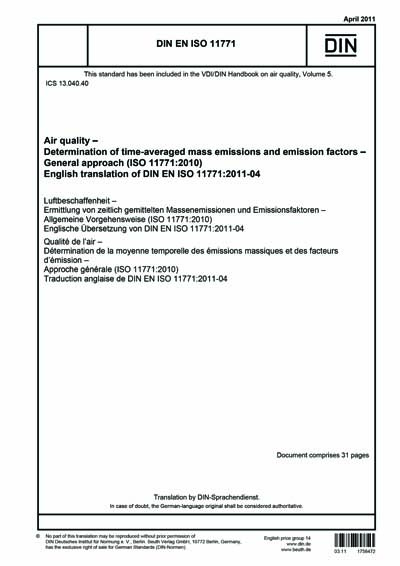Most recent
DIN EN ISO 11771:2011
Air quality - Determination of time-averaged mass emissions and emission factors - General approach (ISO 11771:2010); German version EN ISO 11771:2010
This International Standard specifies a generic method for the determination and the reporting of time averaged mass emissions from a specific installation, or of a family of installations (or common source type), using data collected by measurement, and by establishing - mass emission rates by the simultaneous measurement of concentration and gas flow, using standardized manual or continuous methods, and also the estimation of the uncertainty of the measurement, - time averaged mass emission rates using time series of mass emission rate values, their uncertainty characteristics, and also the determination of the expanded uncertainty of the average, - time averaged emissions factors for a specific installation or of afamily of installations and their associated uncertainty characteristics, and - a quality management system to assist the process of inventory quality assurance and verification. This International Standard is applicable to determining emissions factors or emissions reduction efficiency (both simultaneous and sequential) from stationary sources, including for emissions from industrial processes where calculation from fuel and raw material is not practical, greenhouse gases, and air pollutants including fine particulate material. This standard does not address compliance monitoring in the context of emission control regulations. This International Standard requires the use of measurement based methods and calculation-based methods that use measurement data. It covers the planning and execution of the measurement programme to collect data, selection of sampling methods, calculation of results, estimation of uncertainty, determination of emissions factors, and the reporting of informationin a form that enables users to apply them. This standard specifies how to - generate time averaged mass emissions rate data of a known quality, for a defined period of time, and a documented set of operational conditions, and - generate complete data sets representative of a known time period (i.e. a calendar year) by filling gaps in mass emissions rate data series and combining data sets numerically, NOTE: Time series data may be available for only a limited elapsed period (i.e. weeks, months, or years) and may be available only for a discrete process whereas inventories may be necessary which average over a different period (i.e. for a calendar year). - calculate emissions factors for a known time period, and - calculate time averaged emissions factors of a known quality for a known source type. The measurement of emissions from vehicular, area, or fugitive sources is not specifically covered. However, the standard can be used for quantification of emissions factors for those sources provided that measurements of emissions are available. This International Standard does not explicitly include measurement procedures that are fully described in the published standards in the normative references or in the bibliography. Neither does it provide advice on the generation of activity statistics. This International standard is compatible with ISO 14064 Part 1 and Part 3.*This International Standard specifies generic methods for the determination and reporting of time averaged mass emissions from a specific installation or from a family of installations (or common source type), using data collected by measurement. This includes the determination of mass emission rates by the simultaneous measurement of mass concentration and gas flow, using standardized manual or continuous methods and also the estimation of the uncertainty of the mass emission rates. This International Standard also deals with the determination of the time averaged mass emission rates using time series emission rate values as well as the estimation of the expanded uncertainty of the average. Similarly, the determination of time averaged emission factors for a specific installation or a family of installations and the estimation of their associated uncertainty characteristics are described. This International Standard is applicable for determining emission factors or emissions reduction efficiency from stationary sources, including emissions from industrial processes where calculation based on fuel and raw material is not practical. It does not deal with limit compliance monitoring in the context of emission control regulations. This International Standard requires the use of measurement-based methods and calculation-based methods for the determination of characteristics. It covers the planning and execution of measurement programmes to collect data, selection of measurement procedures, calculation of results, estimation of uncertainty, determination of emissions factors, and the preparation of test reports. The measurement of emissions from vehicular, area, or fugitive sources is not specifically covered. However, this standard can be used for quantification of emissions factors for those sources provided that data from corresponding emission measurements are available. This International Standard does not provide any information on the generation of activity statistics and does not describe the measurement procedures that are fully described in standards. However, these standards are referred to in the normative references and bibliography. This International Standard addresses test laboratories which carry out measurement procedures for the determination of mass emissions and emission factors, operators of facilities who use or report such data, and regulatory authorities which assess the reported results.
Content Provider
Deutsches Institut für Normung [din]






